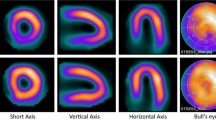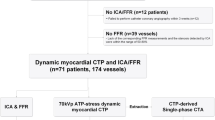Abstract
Background
Attenuation correction (AC) using hardware and software solutions has been shown to increase the specificity of SPECT MPI by decreasing false positive results and improving prognostic ability. Theoretically this should reduce downstream testing and unnecessary costs. We sought to assess the consequences of the use of Gd-153 scanning line source attenuation correction during SPECT myocardial perfusion imaging (MPI) on downstream invasive testing.
Methods
All patients who underwent a clinically indicated Tc-99m stress SPECT MPI study from 2013 to 2015 at five hospitals (2 with AC and 3 without) were retrospectively reviewed. Patient demographics, results of testing, subsequent coronary angiography within 3 months, and revascularization were recorded. The results of the MPI studies, downstream angiogram utilization, and results of angiography were compared and a propensity matched subgroup analysis was performed.
Results
A total of 9968 patients underwent SPECT MPI during the study time period (6106 performed with AC and 3862 without). Out of 3928 patients included in the propensity matched cohort, there was no difference in the proportion of abnormal MPI results between the two groups (31.5% vs 30.4%, P = 0.47), however, more patients underwent coronary angiography within 90 days in the AC group (10.6% vs 8.7%, P = 0.05). There was no significant difference in the proportion of patients with angiographically significant obstructive disease (53.4% vs 56.1%, P = 0.19), however, fewer patients in the AC group with obstructive coronary disease were revascularized (36.1% vs 46.8%, P = 0.04). The findings remained consistent after sub-group analysis in patients without known coronary disease.
Conclusion
The use of scanning line source AC did not meaningfully influence the rate of abnormal MPI results or downstream invasive testing in this cohort. The clinical utility of scanning line source AC may be limited to facilitating stress-first imaging protocols.
Similar content being viewed by others
Abbreviations
- SPECT:
-
Single photon emission computed tomography
- MPI:
-
Myocardial perfusion imaging
- AC:
-
Attenuation correction
- Gd:
-
Gadolinium
- CAD:
-
Coronary artery disease
- SMD:
-
Standard mean difference
- BMI:
-
Body mass index
- OR:
-
Odds ratio
References
Singh B, Bateman TM, Case JA, Heller G (2007) Attenuation artifact, attenuation correction, and the future of myocardial perfusion SPECT. J Nucl Cardiol 14:153-64
Huang JY, Huang CK, Yen RF, Wu HY, Tu YK, Cheng MF et al (2016) Diagnostic performance of attenuation-corrected myocardial perfusion imaging for coronary artery disease: A systematic review and meta-analysis. J Nucl Med 57:1893-98
Pazhenkottil AP, Ghadri JR, Nkoulou RN, Wolfrum M, Buechel RR, Kuest SM et al (2011) Improved outcome prediction by SPECT myocardial perfusion imaging after CT attenuation correction. J Nucl Med 52:196-00
Ardestani A, Ahlberg AW, Katten DM, Santilli K, Polk DM, Bateman TM et al (2014) Risk stratification using line source attenuation correction with rest/stress Tc-99m sestamibi SPECT myocardial perfusion imaging. J Nucl Cardiol 21:118-26
Motwani M, Leslie WD, Goertzen AL, Otaki Y, Germano G, Berman DS et al (2018) Fully automated analysis of attenuation-corrected SPECT for the long-term prediction of acute myocardial infarction. J Nucl Cardiol 25:1353-60
Cuocolo A (2011) Attenuation correction for myocardial perfusion SPECT imaging: Still a controversial issue. Eur J Nucl Med Mol Imaging 38:1887-89
Henzlova MJ, Duvall WL, Einstein AJ, Travin MI, Verberne HJ (2016) ASNC imaging guidelines for SPECT nuclear cardiology procedures: Stress, protocols, and tracers. J Nucl Cardiol 23:606-9
Dorbala S, Ananthasubramaniam K, Armstrong IS, Chareonthaitawee P, DePuey EG, Einstein AJ et al (2018) Single photon emission computed tomography (SPECT) myocardial perfusion imaging guidelines: Instrumentation, acquisition, processing, and interpretation. J Nucl Cardiol 25:1784-46
Austin PC (2011) An introduction to propensity score methods for reducing the effects of confounding in observational studies. Multivariate Behav Res 46:399-24
Hansen BB, Bowers J (2008) Covariate balance in simple, stratified and clustered comparative studies. Stat Sci 23:219-36
Schober P, Bossers SM, Schwarte LA (2018) Statistical significance versus clinical importance of observed effect sizes: What do p values and confidence intervals really represent? Anesth Analg 126:1068-72
Hendel RC (2005) Attenuation correction: Eternal dilemma or real improvement? Q J Nucl Med Mol Imaging 49:30-2
Baghdasarian SB, Noble GL, Ahlberg AW, Katten D, Heller GV (2009) Risk stratification with attenuation corrected stress Tc-99m sestamibi SPECT myocardial perfusion imaging in the absence of ECG-gating due to arrhythmias. J Nucl Cardiol 16:533-39
Ou X, Jiang L, Huang R, Li F, Zhao Z, Li L (2013) Computed tomography attenuation correction improves the risk stratification accuracy of myocardial perfusion imaging. Nucl Med Commun 34:495-00
Hendel RC, Berman DS, Cullom SJ, Follansbee W, Heller GV, Kiat H et al (1999) Multicenter clinical trial to evaluate the efficacy of correction for photon attenuation and scatter in SPECT myocardial perfusion imaging. Circulation 99:2742-49
Heller GV, Bateman TM, Johnson LL, Cullom SJ, Case JA, Galt JR et al (2004) Clinical value of attenuation correction in stress-only Tc-99m sestamibi SPECT imaging. J Nucl Cardiol 11:273-81
Mathur S, Heller GV, Bateman TM, Ruffin R, Yekta A, Katten D et al (2013) Clinical value of stress-only Tc-99m SPECT imaging: Importance of attenuation correction. J Nucl Cardiol 20:27-7
Hachamovitch R, Nutter B, Hlatky MA, Shaw LJ, Ridner ML, Dorbala S et al (2012) Patient management after noninvasive cardiac imaging results from SPARC (Study of myocardial perfusion and coronary anatomy imaging roles in coronary artery disease). J Am Coll Cardiol 59:462-74
Author information
Authors and Affiliations
Corresponding author
Additional information
Publisher's Note
Springer Nature remains neutral with regard to jurisdictional claims in published maps and institutional affiliations.
The authors of this article have provided a PowerPoint file, available for download at SpringerLink, which summarises the contents of the paper and is free for re-use at meetings and presentations. Search for the article DOI on SpringerLink.com.
The authors have also provided an audio summary of the article, which is available to download as ESM, or to listen to via the JNC/ASNC Podcast.
Supplementary Information
Below is the link to the electronic supplementary material.
Rights and permissions
About this article
Cite this article
Singhvi, A., Suacier, S., Verma, I. et al. Impact of Gd-153 scanning line source attenuation correction on downstream invasive testing. J. Nucl. Cardiol. 29, 1832–1842 (2022). https://doi.org/10.1007/s12350-021-02565-2
Received:
Accepted:
Published:
Issue Date:
DOI: https://doi.org/10.1007/s12350-021-02565-2




